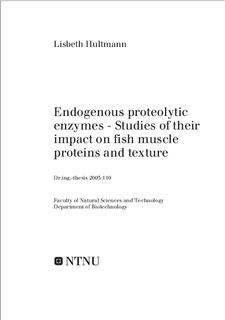| dc.contributor.author | Hultmann, Lisbeth | nb_NO |
| dc.date.accessioned | 2014-12-19T13:14:06Z | |
| dc.date.available | 2014-12-19T13:14:06Z | |
| dc.date.created | 2004-01-22 | nb_NO |
| dc.date.issued | 2004 | nb_NO |
| dc.identifier | 123095 | nb_NO |
| dc.identifier.isbn | 82-471-5666-0 | nb_NO |
| dc.identifier.uri | http://hdl.handle.net/11250/245573 | |
| dc.description.abstract | This thesis covers studies on endogenous proteolytic enzymes and their impact on fish muscle proteins and texture. The studies have been performed using Atlantic salmon (Salmo salar) and cod (Gadus morhua) subjected to different treatments and storage conditions.
The textural properties were very different in the two species. Salmon fillets were significantly softer and less resilient than cod fillets, and the properties changed somewhat differently during storage experiments. Different proteolytic enzymes have been reported to participate in muscle softening. Some of these enzymes were investigated, and specific proteolytic activities were detected throughout the storage periods. Collagenase-like enzymes seem to be the most important for cod muscle texture. Microorganisms and/or microbial enzymes seem not to be important for changes in salmon muscle texture. Results suggest that the cathepsin B-like enzymes are important for salmon texture. The activities of the proteolytic enzymes may be greatly affected by the muscle pH, and by the treatment(s) the fish are subjected to. In any case, changes caused by differences in proteolytic activities may need some time to be detectable or have significant impact on fish quality.
When cod fillets are stored in ice, it is highly recommended to keep the temperature low. Even a relatively mild temperature abuse was sufficient to result in less favorable textural characteristics, and make the fillets seem older than their days of storage.
Salmon fillets are often subjected to cold-smoking. The smoking temperature was important for the solubility properties of the muscle proteins, and for their composition, but did not affect the proteolytic activity. The effects of the processing parameters were most important early in the product’s shelf life, as the differences caused by the different smoking temperatures were reduced by further storage of the smoked samples. | nb_NO |
| dc.language | eng | nb_NO |
| dc.publisher | Fakultet for naturvitenskap og teknologi | nb_NO |
| dc.relation.ispartofseries | Dr. ingeniøravhandling, 0809-103X; 2003:110 | nb_NO |
| dc.relation.haspart | Hultmann, Lisbeth; Rustad, Turid. Texture changes during iced storage of salmon (Salmo salar) and cod (Gadus morhua). Journal of Aquatic Food Product Technology. 11(3-4): 105-123, 2002. | nb_NO |
| dc.relation.haspart | Hultmann, Lisbeth; Rustad, Turid. Iced storage of Atlantic salmon (Salmo salar) – effects on endogenous enzymes and their impact on muscle proteins and texture. Food Chemistry. 87(1): 31-41, 2004. | nb_NO |
| dc.relation.haspart | Hultmann, Lisbeth; Rørå, Anna Maria Bencze; Steinsland, Ingelin; Skåra, Torstein; Rustad, Turid. Proteolytic activity and properties of proteins in smoked salmon (Salmo salar)—effects of smoking temperature. Food Chemistry. 85(3): 377-387, 2004. | nb_NO |
| dc.relation.haspart | Hultmann, Lisbeth; Rustad, Turid. Texture, proteins and proteolytic enzymes in farmed Atlantic cod (Gadus morhua). . | nb_NO |
| dc.subject | Biotechnology | en_GB |
| dc.subject | TECHNOLOGY: Bioengineering | en_GB |
| dc.title | Endogenous proteolytic enzymes - Studies of their impact on fish muscle proteins and texture | nb_NO |
| dc.type | Doctoral thesis | nb_NO |
| dc.source.pagenumber | 111 | nb_NO |
| dc.contributor.department | Norges teknisk-naturvitenskapelige universitet, Fakultet for naturvitenskap og teknologi, Institutt for bioteknologi | nb_NO |
| dc.description.degree | dr.ing. | nb_NO |
| dc.description.degree | dr.ing. | en_GB |
